Analyzing the Quality of Life of Obese Populations in New Zealand
VerifiedAdded on 2022/08/23
|10
|2281
|20
Report
AI Summary
This report examines the prevalence and impact of obesity on the quality of life of individuals in New Zealand, with a particular focus on the indigenous Māori and Pacific Islander populations. It highlights the significant increase in obesity rates among adults and children, linking it to factors such as dietary habits, community environment, and genetics. The report identifies associated health issues, including increased risks of diabetes, cardiovascular diseases, and mental health problems. Furthermore, it discusses strategies to combat obesity, including educational initiatives, food labeling, and community-based programs like the Healthy Eating and Healthy Action policy, emphasizing partnership, protection, and participation. The conclusion underscores the need for continued efforts and inclusive policies to address obesity and improve health outcomes across all communities in New Zealand. Desklib provides access to similar reports and study resources for students.
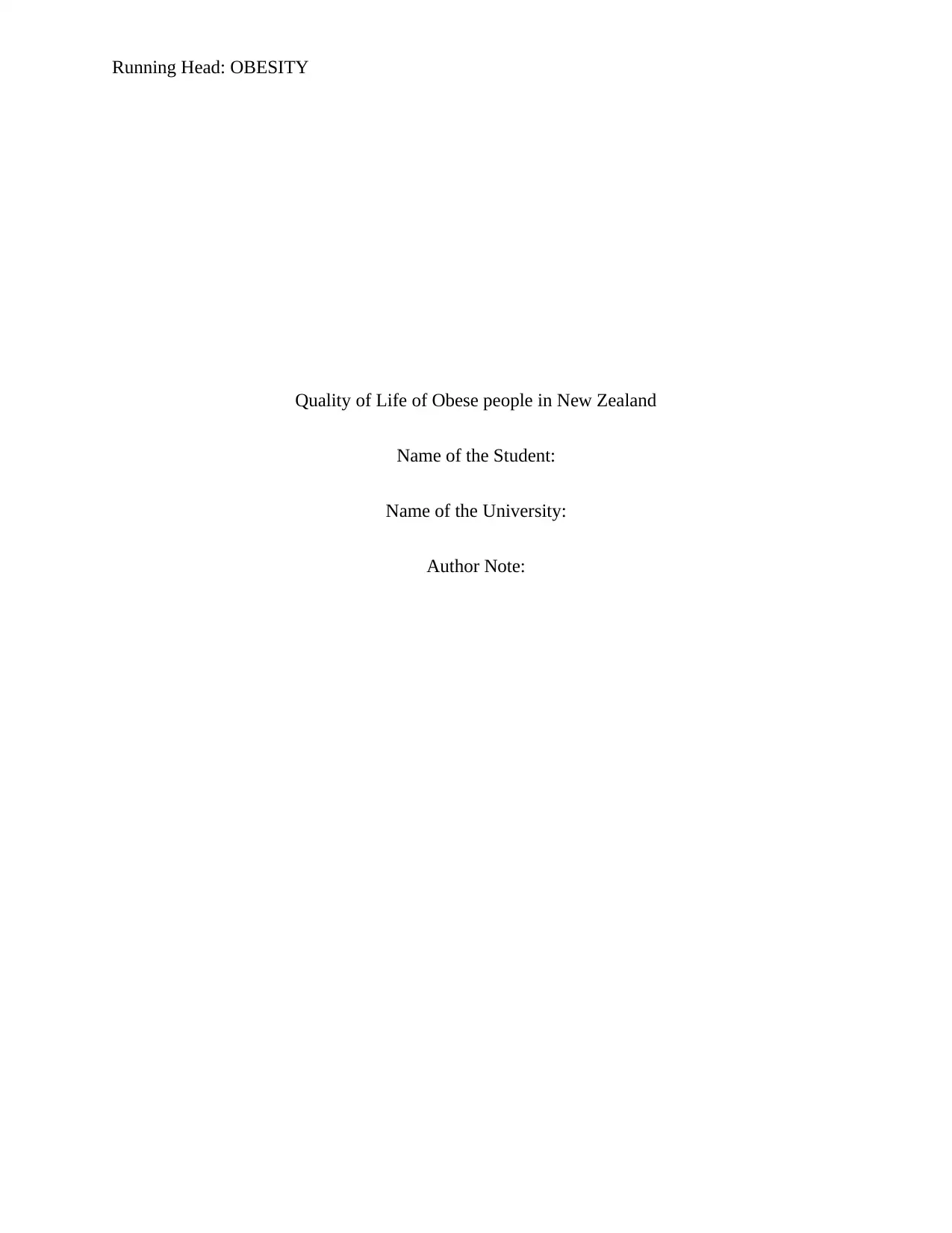
Running Head: OBESITY
Quality of Life of Obese people in New Zealand
Name of the Student:
Name of the University:
Author Note:
Quality of Life of Obese people in New Zealand
Name of the Student:
Name of the University:
Author Note:
Paraphrase This Document
Need a fresh take? Get an instant paraphrase of this document with our AI Paraphraser
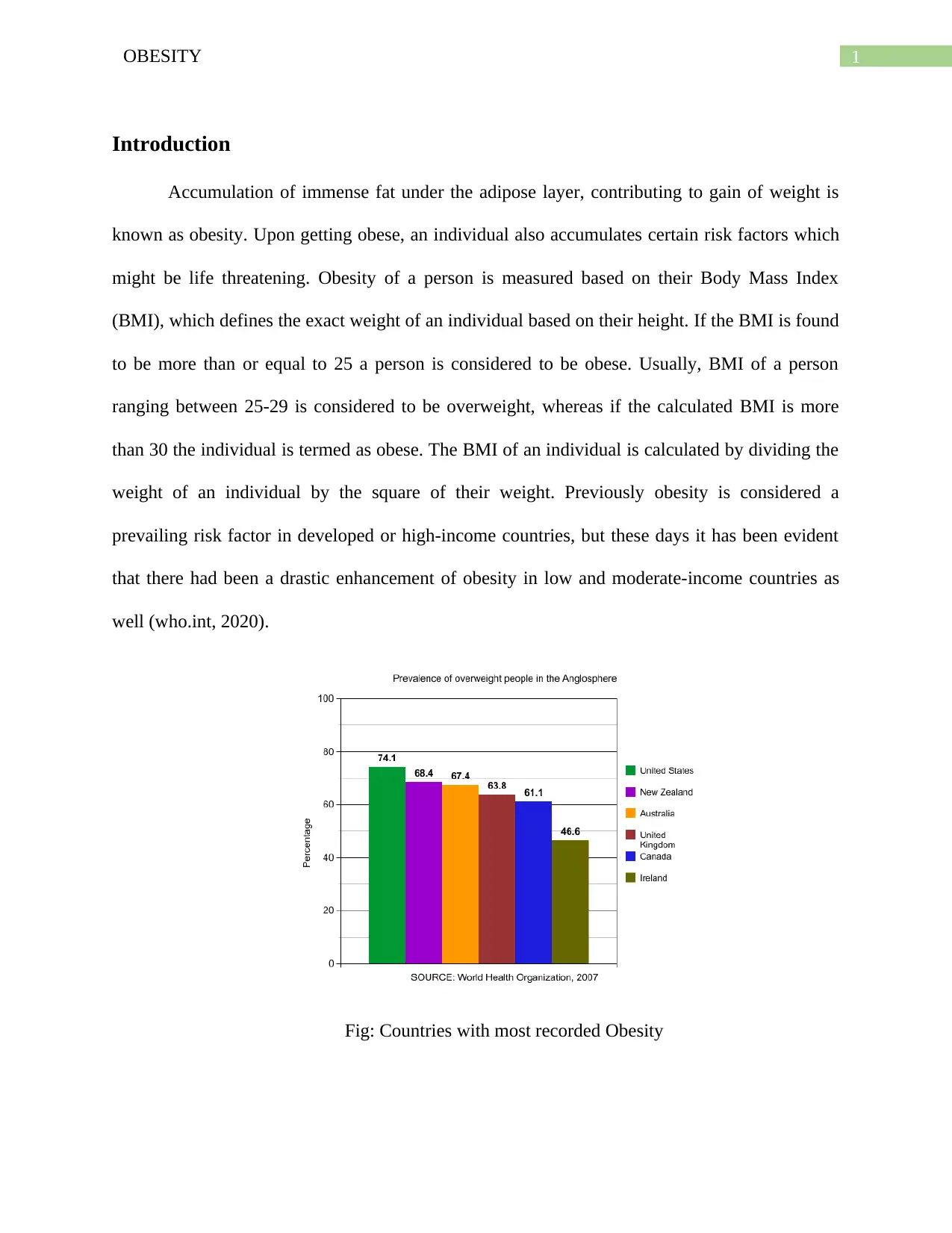
1OBESITY
Introduction
Accumulation of immense fat under the adipose layer, contributing to gain of weight is
known as obesity. Upon getting obese, an individual also accumulates certain risk factors which
might be life threatening. Obesity of a person is measured based on their Body Mass Index
(BMI), which defines the exact weight of an individual based on their height. If the BMI is found
to be more than or equal to 25 a person is considered to be obese. Usually, BMI of a person
ranging between 25-29 is considered to be overweight, whereas if the calculated BMI is more
than 30 the individual is termed as obese. The BMI of an individual is calculated by dividing the
weight of an individual by the square of their weight. Previously obesity is considered a
prevailing risk factor in developed or high-income countries, but these days it has been evident
that there had been a drastic enhancement of obesity in low and moderate-income countries as
well (who.int, 2020).
Fig: Countries with most recorded Obesity
Introduction
Accumulation of immense fat under the adipose layer, contributing to gain of weight is
known as obesity. Upon getting obese, an individual also accumulates certain risk factors which
might be life threatening. Obesity of a person is measured based on their Body Mass Index
(BMI), which defines the exact weight of an individual based on their height. If the BMI is found
to be more than or equal to 25 a person is considered to be obese. Usually, BMI of a person
ranging between 25-29 is considered to be overweight, whereas if the calculated BMI is more
than 30 the individual is termed as obese. The BMI of an individual is calculated by dividing the
weight of an individual by the square of their weight. Previously obesity is considered a
prevailing risk factor in developed or high-income countries, but these days it has been evident
that there had been a drastic enhancement of obesity in low and moderate-income countries as
well (who.int, 2020).
Fig: Countries with most recorded Obesity
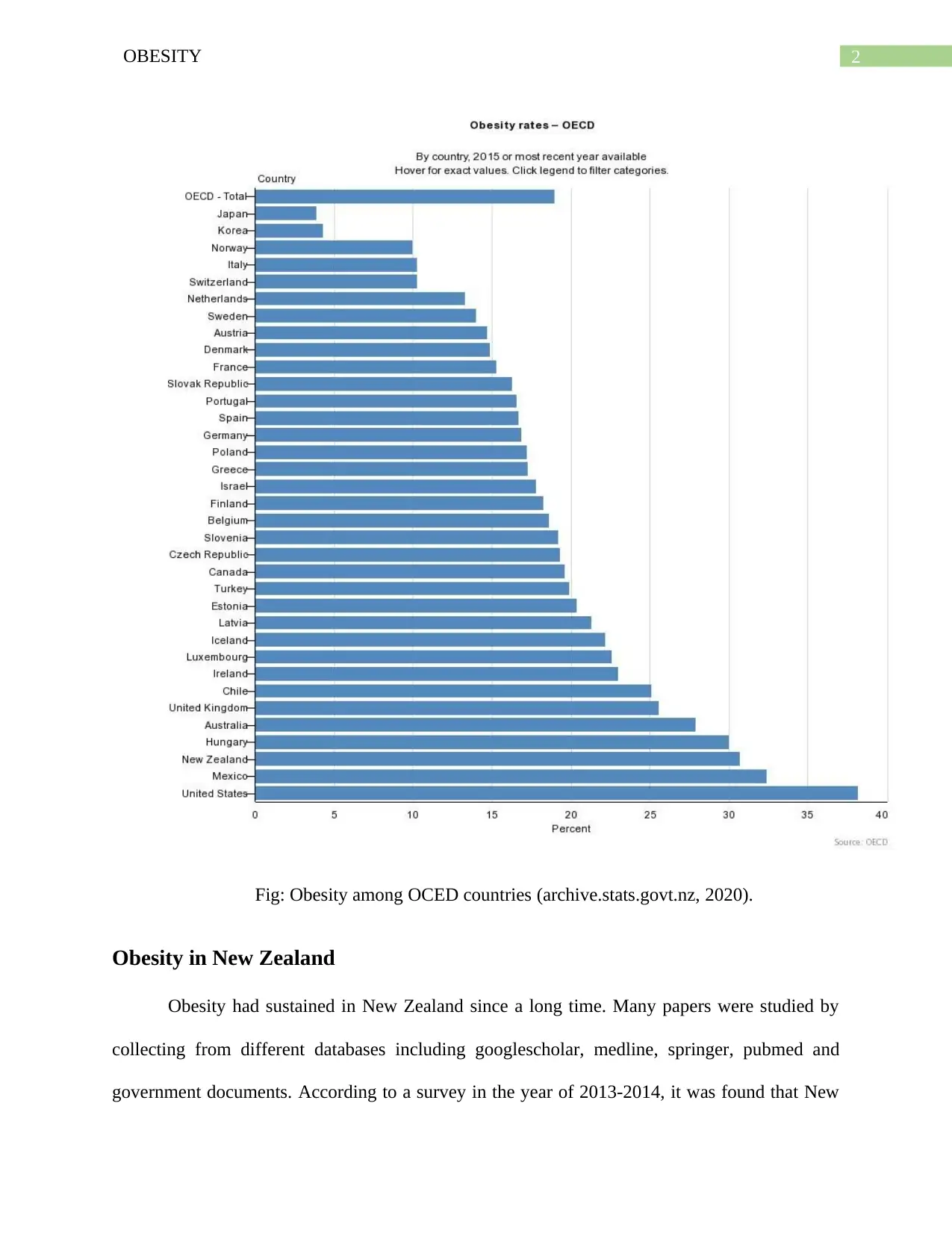
2OBESITY
Fig: Obesity among OCED countries (archive.stats.govt.nz, 2020).
Obesity in New Zealand
Obesity had sustained in New Zealand since a long time. Many papers were studied by
collecting from different databases including googlescholar, medline, springer, pubmed and
government documents. According to a survey in the year of 2013-2014, it was found that New
Fig: Obesity among OCED countries (archive.stats.govt.nz, 2020).
Obesity in New Zealand
Obesity had sustained in New Zealand since a long time. Many papers were studied by
collecting from different databases including googlescholar, medline, springer, pubmed and
government documents. According to a survey in the year of 2013-2014, it was found that New
⊘ This is a preview!⊘
Do you want full access?
Subscribe today to unlock all pages.

Trusted by 1+ million students worldwide
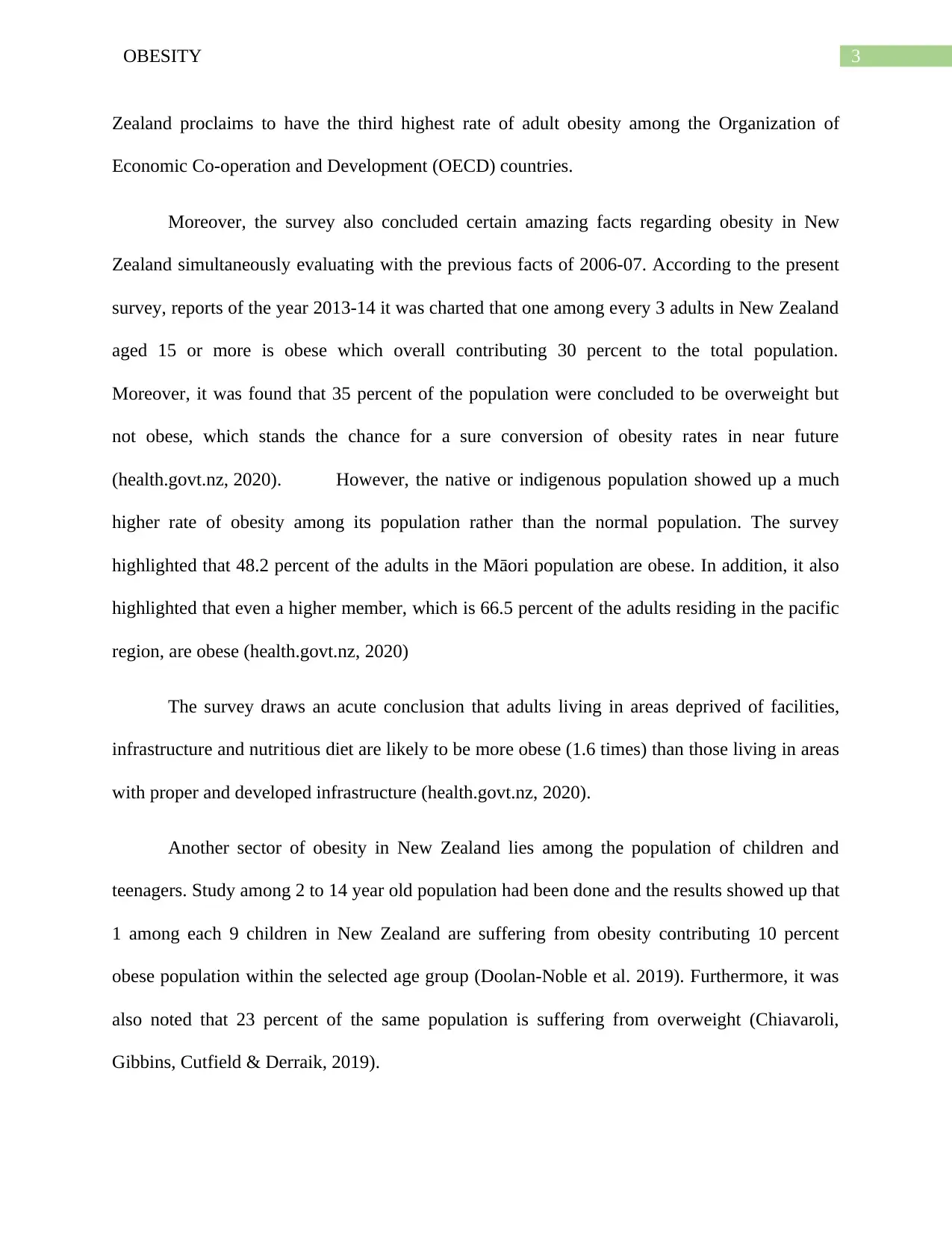
3OBESITY
Zealand proclaims to have the third highest rate of adult obesity among the Organization of
Economic Co-operation and Development (OECD) countries.
Moreover, the survey also concluded certain amazing facts regarding obesity in New
Zealand simultaneously evaluating with the previous facts of 2006-07. According to the present
survey, reports of the year 2013-14 it was charted that one among every 3 adults in New Zealand
aged 15 or more is obese which overall contributing 30 percent to the total population.
Moreover, it was found that 35 percent of the population were concluded to be overweight but
not obese, which stands the chance for a sure conversion of obesity rates in near future
(health.govt.nz, 2020). However, the native or indigenous population showed up a much
higher rate of obesity among its population rather than the normal population. The survey
highlighted that 48.2 percent of the adults in the Māori population are obese. In addition, it also
highlighted that even a higher member, which is 66.5 percent of the adults residing in the pacific
region, are obese (health.govt.nz, 2020)
The survey draws an acute conclusion that adults living in areas deprived of facilities,
infrastructure and nutritious diet are likely to be more obese (1.6 times) than those living in areas
with proper and developed infrastructure (health.govt.nz, 2020).
Another sector of obesity in New Zealand lies among the population of children and
teenagers. Study among 2 to 14 year old population had been done and the results showed up that
1 among each 9 children in New Zealand are suffering from obesity contributing 10 percent
obese population within the selected age group (Doolan-Noble et al. 2019). Furthermore, it was
also noted that 23 percent of the same population is suffering from overweight (Chiavaroli,
Gibbins, Cutfield & Derraik, 2019).
Zealand proclaims to have the third highest rate of adult obesity among the Organization of
Economic Co-operation and Development (OECD) countries.
Moreover, the survey also concluded certain amazing facts regarding obesity in New
Zealand simultaneously evaluating with the previous facts of 2006-07. According to the present
survey, reports of the year 2013-14 it was charted that one among every 3 adults in New Zealand
aged 15 or more is obese which overall contributing 30 percent to the total population.
Moreover, it was found that 35 percent of the population were concluded to be overweight but
not obese, which stands the chance for a sure conversion of obesity rates in near future
(health.govt.nz, 2020). However, the native or indigenous population showed up a much
higher rate of obesity among its population rather than the normal population. The survey
highlighted that 48.2 percent of the adults in the Māori population are obese. In addition, it also
highlighted that even a higher member, which is 66.5 percent of the adults residing in the pacific
region, are obese (health.govt.nz, 2020)
The survey draws an acute conclusion that adults living in areas deprived of facilities,
infrastructure and nutritious diet are likely to be more obese (1.6 times) than those living in areas
with proper and developed infrastructure (health.govt.nz, 2020).
Another sector of obesity in New Zealand lies among the population of children and
teenagers. Study among 2 to 14 year old population had been done and the results showed up that
1 among each 9 children in New Zealand are suffering from obesity contributing 10 percent
obese population within the selected age group (Doolan-Noble et al. 2019). Furthermore, it was
also noted that 23 percent of the same population is suffering from overweight (Chiavaroli,
Gibbins, Cutfield & Derraik, 2019).
Paraphrase This Document
Need a fresh take? Get an instant paraphrase of this document with our AI Paraphraser
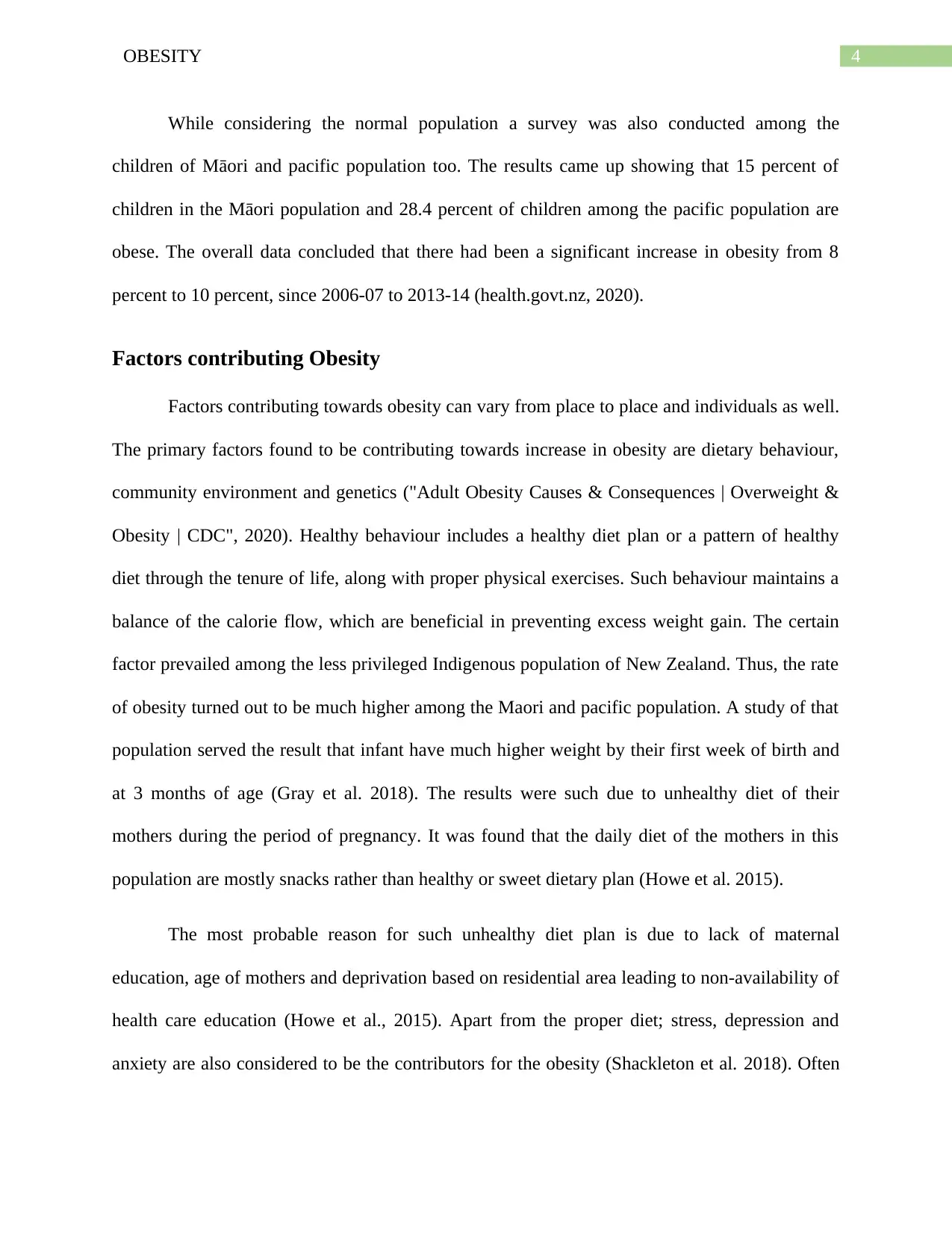
4OBESITY
While considering the normal population a survey was also conducted among the
children of Māori and pacific population too. The results came up showing that 15 percent of
children in the Māori population and 28.4 percent of children among the pacific population are
obese. The overall data concluded that there had been a significant increase in obesity from 8
percent to 10 percent, since 2006-07 to 2013-14 (health.govt.nz, 2020).
Factors contributing Obesity
Factors contributing towards obesity can vary from place to place and individuals as well.
The primary factors found to be contributing towards increase in obesity are dietary behaviour,
community environment and genetics ("Adult Obesity Causes & Consequences | Overweight &
Obesity | CDC", 2020). Healthy behaviour includes a healthy diet plan or a pattern of healthy
diet through the tenure of life, along with proper physical exercises. Such behaviour maintains a
balance of the calorie flow, which are beneficial in preventing excess weight gain. The certain
factor prevailed among the less privileged Indigenous population of New Zealand. Thus, the rate
of obesity turned out to be much higher among the Maori and pacific population. A study of that
population served the result that infant have much higher weight by their first week of birth and
at 3 months of age (Gray et al. 2018). The results were such due to unhealthy diet of their
mothers during the period of pregnancy. It was found that the daily diet of the mothers in this
population are mostly snacks rather than healthy or sweet dietary plan (Howe et al. 2015).
The most probable reason for such unhealthy diet plan is due to lack of maternal
education, age of mothers and deprivation based on residential area leading to non-availability of
health care education (Howe et al., 2015). Apart from the proper diet; stress, depression and
anxiety are also considered to be the contributors for the obesity (Shackleton et al. 2018). Often
While considering the normal population a survey was also conducted among the
children of Māori and pacific population too. The results came up showing that 15 percent of
children in the Māori population and 28.4 percent of children among the pacific population are
obese. The overall data concluded that there had been a significant increase in obesity from 8
percent to 10 percent, since 2006-07 to 2013-14 (health.govt.nz, 2020).
Factors contributing Obesity
Factors contributing towards obesity can vary from place to place and individuals as well.
The primary factors found to be contributing towards increase in obesity are dietary behaviour,
community environment and genetics ("Adult Obesity Causes & Consequences | Overweight &
Obesity | CDC", 2020). Healthy behaviour includes a healthy diet plan or a pattern of healthy
diet through the tenure of life, along with proper physical exercises. Such behaviour maintains a
balance of the calorie flow, which are beneficial in preventing excess weight gain. The certain
factor prevailed among the less privileged Indigenous population of New Zealand. Thus, the rate
of obesity turned out to be much higher among the Maori and pacific population. A study of that
population served the result that infant have much higher weight by their first week of birth and
at 3 months of age (Gray et al. 2018). The results were such due to unhealthy diet of their
mothers during the period of pregnancy. It was found that the daily diet of the mothers in this
population are mostly snacks rather than healthy or sweet dietary plan (Howe et al. 2015).
The most probable reason for such unhealthy diet plan is due to lack of maternal
education, age of mothers and deprivation based on residential area leading to non-availability of
health care education (Howe et al., 2015). Apart from the proper diet; stress, depression and
anxiety are also considered to be the contributors for the obesity (Shackleton et al. 2018). Often
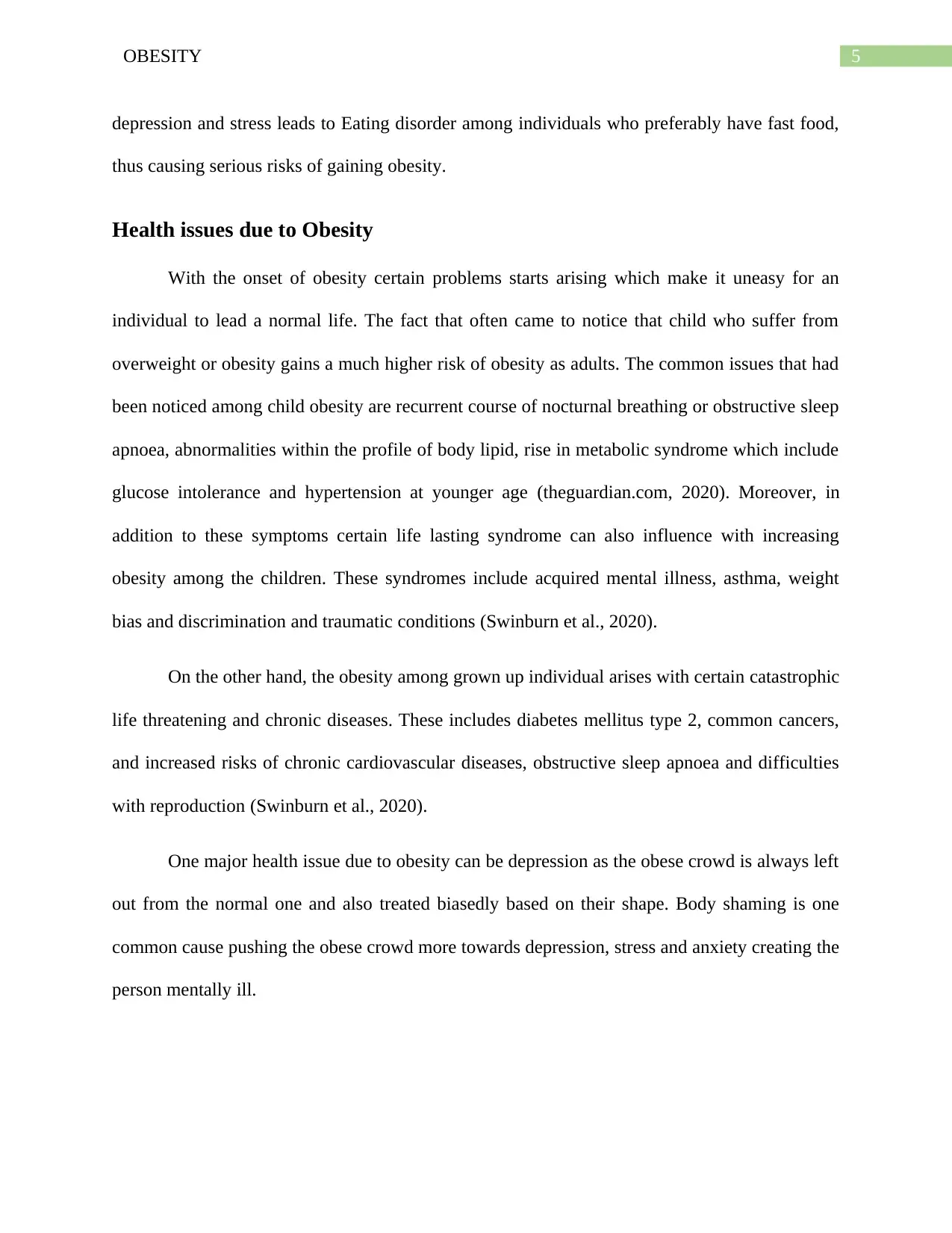
5OBESITY
depression and stress leads to Eating disorder among individuals who preferably have fast food,
thus causing serious risks of gaining obesity.
Health issues due to Obesity
With the onset of obesity certain problems starts arising which make it uneasy for an
individual to lead a normal life. The fact that often came to notice that child who suffer from
overweight or obesity gains a much higher risk of obesity as adults. The common issues that had
been noticed among child obesity are recurrent course of nocturnal breathing or obstructive sleep
apnoea, abnormalities within the profile of body lipid, rise in metabolic syndrome which include
glucose intolerance and hypertension at younger age (theguardian.com, 2020). Moreover, in
addition to these symptoms certain life lasting syndrome can also influence with increasing
obesity among the children. These syndromes include acquired mental illness, asthma, weight
bias and discrimination and traumatic conditions (Swinburn et al., 2020).
On the other hand, the obesity among grown up individual arises with certain catastrophic
life threatening and chronic diseases. These includes diabetes mellitus type 2, common cancers,
and increased risks of chronic cardiovascular diseases, obstructive sleep apnoea and difficulties
with reproduction (Swinburn et al., 2020).
One major health issue due to obesity can be depression as the obese crowd is always left
out from the normal one and also treated biasedly based on their shape. Body shaming is one
common cause pushing the obese crowd more towards depression, stress and anxiety creating the
person mentally ill.
depression and stress leads to Eating disorder among individuals who preferably have fast food,
thus causing serious risks of gaining obesity.
Health issues due to Obesity
With the onset of obesity certain problems starts arising which make it uneasy for an
individual to lead a normal life. The fact that often came to notice that child who suffer from
overweight or obesity gains a much higher risk of obesity as adults. The common issues that had
been noticed among child obesity are recurrent course of nocturnal breathing or obstructive sleep
apnoea, abnormalities within the profile of body lipid, rise in metabolic syndrome which include
glucose intolerance and hypertension at younger age (theguardian.com, 2020). Moreover, in
addition to these symptoms certain life lasting syndrome can also influence with increasing
obesity among the children. These syndromes include acquired mental illness, asthma, weight
bias and discrimination and traumatic conditions (Swinburn et al., 2020).
On the other hand, the obesity among grown up individual arises with certain catastrophic
life threatening and chronic diseases. These includes diabetes mellitus type 2, common cancers,
and increased risks of chronic cardiovascular diseases, obstructive sleep apnoea and difficulties
with reproduction (Swinburn et al., 2020).
One major health issue due to obesity can be depression as the obese crowd is always left
out from the normal one and also treated biasedly based on their shape. Body shaming is one
common cause pushing the obese crowd more towards depression, stress and anxiety creating the
person mentally ill.
⊘ This is a preview!⊘
Do you want full access?
Subscribe today to unlock all pages.

Trusted by 1+ million students worldwide
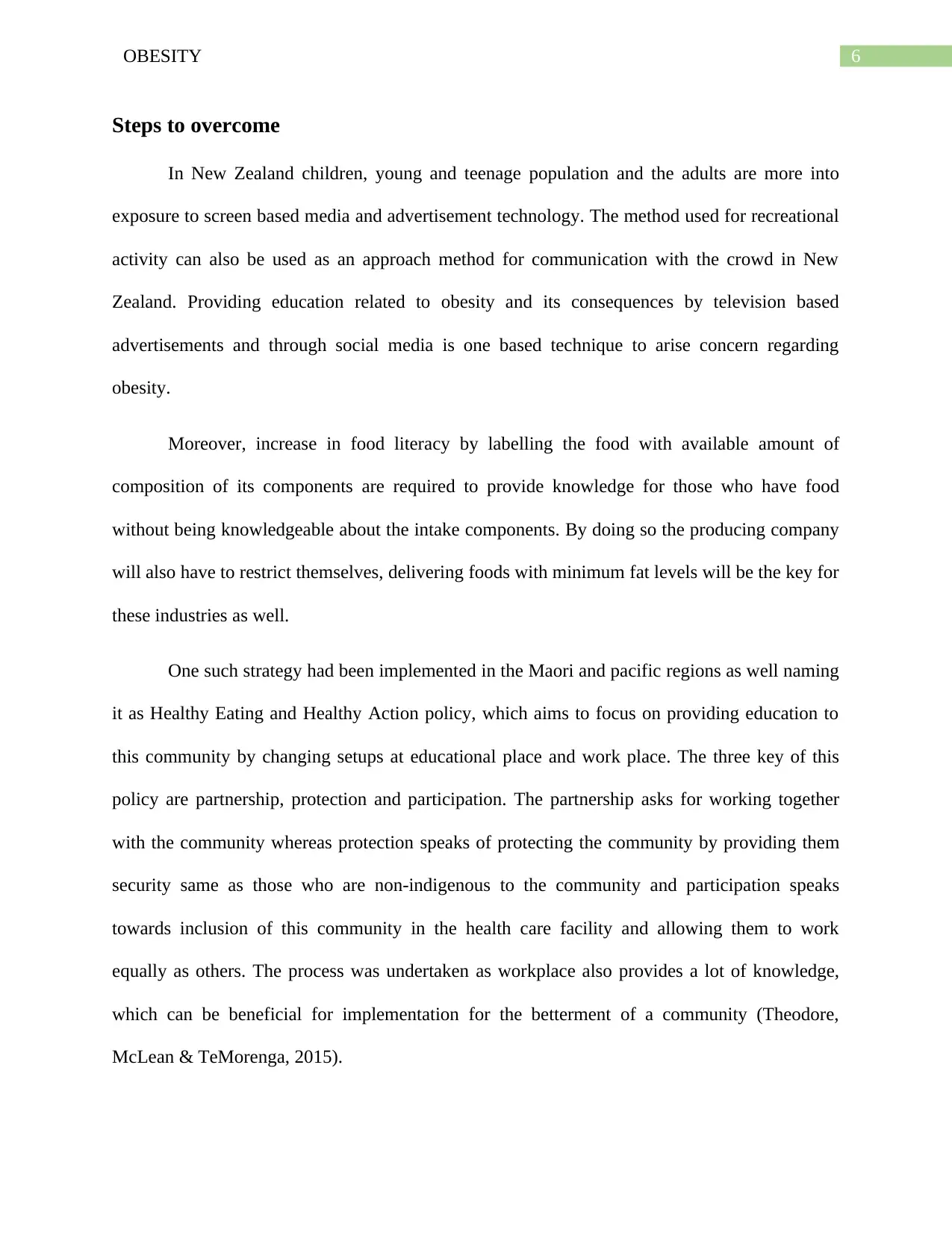
6OBESITY
Steps to overcome
In New Zealand children, young and teenage population and the adults are more into
exposure to screen based media and advertisement technology. The method used for recreational
activity can also be used as an approach method for communication with the crowd in New
Zealand. Providing education related to obesity and its consequences by television based
advertisements and through social media is one based technique to arise concern regarding
obesity.
Moreover, increase in food literacy by labelling the food with available amount of
composition of its components are required to provide knowledge for those who have food
without being knowledgeable about the intake components. By doing so the producing company
will also have to restrict themselves, delivering foods with minimum fat levels will be the key for
these industries as well.
One such strategy had been implemented in the Maori and pacific regions as well naming
it as Healthy Eating and Healthy Action policy, which aims to focus on providing education to
this community by changing setups at educational place and work place. The three key of this
policy are partnership, protection and participation. The partnership asks for working together
with the community whereas protection speaks of protecting the community by providing them
security same as those who are non-indigenous to the community and participation speaks
towards inclusion of this community in the health care facility and allowing them to work
equally as others. The process was undertaken as workplace also provides a lot of knowledge,
which can be beneficial for implementation for the betterment of a community (Theodore,
McLean & TeMorenga, 2015).
Steps to overcome
In New Zealand children, young and teenage population and the adults are more into
exposure to screen based media and advertisement technology. The method used for recreational
activity can also be used as an approach method for communication with the crowd in New
Zealand. Providing education related to obesity and its consequences by television based
advertisements and through social media is one based technique to arise concern regarding
obesity.
Moreover, increase in food literacy by labelling the food with available amount of
composition of its components are required to provide knowledge for those who have food
without being knowledgeable about the intake components. By doing so the producing company
will also have to restrict themselves, delivering foods with minimum fat levels will be the key for
these industries as well.
One such strategy had been implemented in the Maori and pacific regions as well naming
it as Healthy Eating and Healthy Action policy, which aims to focus on providing education to
this community by changing setups at educational place and work place. The three key of this
policy are partnership, protection and participation. The partnership asks for working together
with the community whereas protection speaks of protecting the community by providing them
security same as those who are non-indigenous to the community and participation speaks
towards inclusion of this community in the health care facility and allowing them to work
equally as others. The process was undertaken as workplace also provides a lot of knowledge,
which can be beneficial for implementation for the betterment of a community (Theodore,
McLean & TeMorenga, 2015).
Paraphrase This Document
Need a fresh take? Get an instant paraphrase of this document with our AI Paraphraser
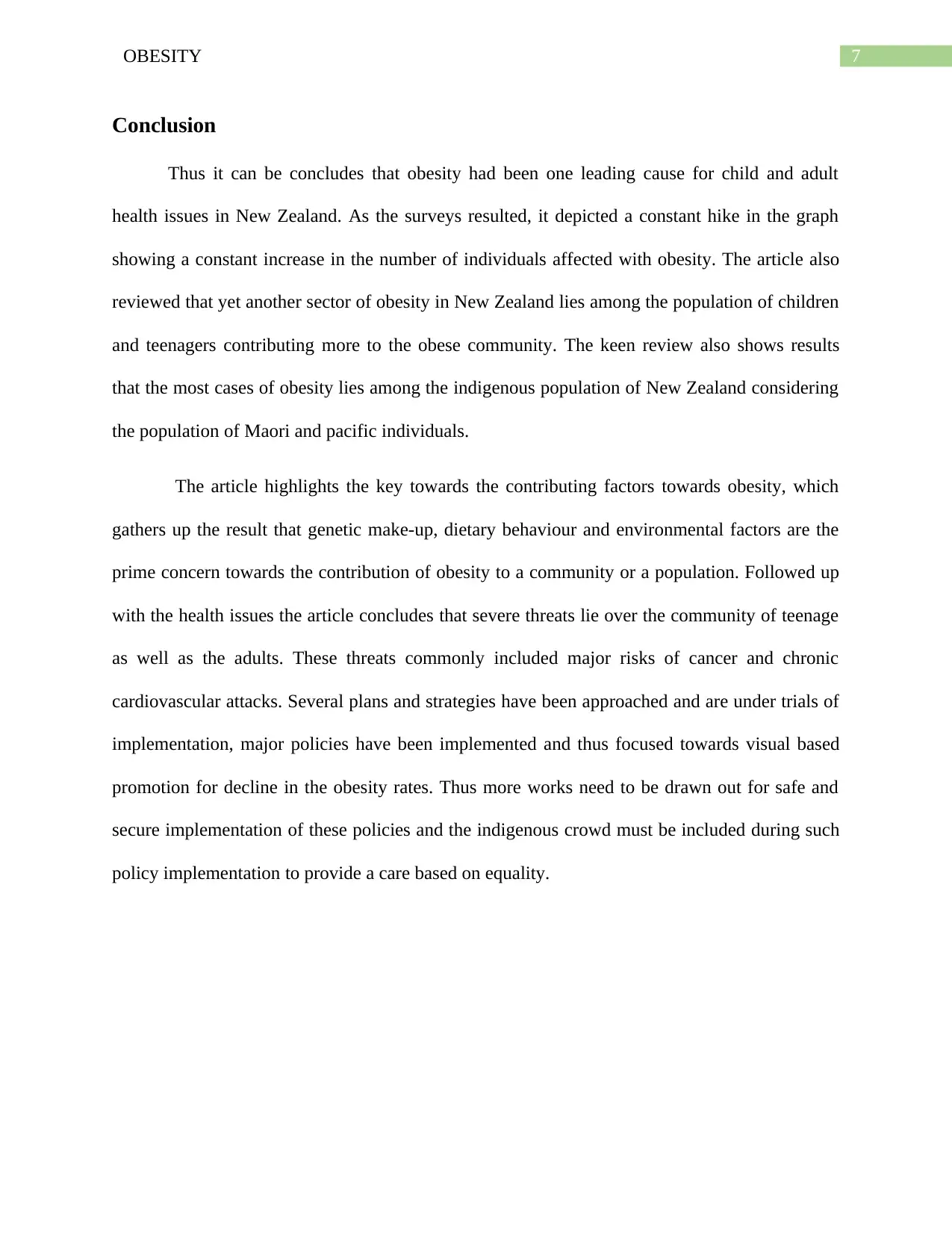
7OBESITY
Conclusion
Thus it can be concludes that obesity had been one leading cause for child and adult
health issues in New Zealand. As the surveys resulted, it depicted a constant hike in the graph
showing a constant increase in the number of individuals affected with obesity. The article also
reviewed that yet another sector of obesity in New Zealand lies among the population of children
and teenagers contributing more to the obese community. The keen review also shows results
that the most cases of obesity lies among the indigenous population of New Zealand considering
the population of Maori and pacific individuals.
The article highlights the key towards the contributing factors towards obesity, which
gathers up the result that genetic make-up, dietary behaviour and environmental factors are the
prime concern towards the contribution of obesity to a community or a population. Followed up
with the health issues the article concludes that severe threats lie over the community of teenage
as well as the adults. These threats commonly included major risks of cancer and chronic
cardiovascular attacks. Several plans and strategies have been approached and are under trials of
implementation, major policies have been implemented and thus focused towards visual based
promotion for decline in the obesity rates. Thus more works need to be drawn out for safe and
secure implementation of these policies and the indigenous crowd must be included during such
policy implementation to provide a care based on equality.
Conclusion
Thus it can be concludes that obesity had been one leading cause for child and adult
health issues in New Zealand. As the surveys resulted, it depicted a constant hike in the graph
showing a constant increase in the number of individuals affected with obesity. The article also
reviewed that yet another sector of obesity in New Zealand lies among the population of children
and teenagers contributing more to the obese community. The keen review also shows results
that the most cases of obesity lies among the indigenous population of New Zealand considering
the population of Maori and pacific individuals.
The article highlights the key towards the contributing factors towards obesity, which
gathers up the result that genetic make-up, dietary behaviour and environmental factors are the
prime concern towards the contribution of obesity to a community or a population. Followed up
with the health issues the article concludes that severe threats lie over the community of teenage
as well as the adults. These threats commonly included major risks of cancer and chronic
cardiovascular attacks. Several plans and strategies have been approached and are under trials of
implementation, major policies have been implemented and thus focused towards visual based
promotion for decline in the obesity rates. Thus more works need to be drawn out for safe and
secure implementation of these policies and the indigenous crowd must be included during such
policy implementation to provide a care based on equality.
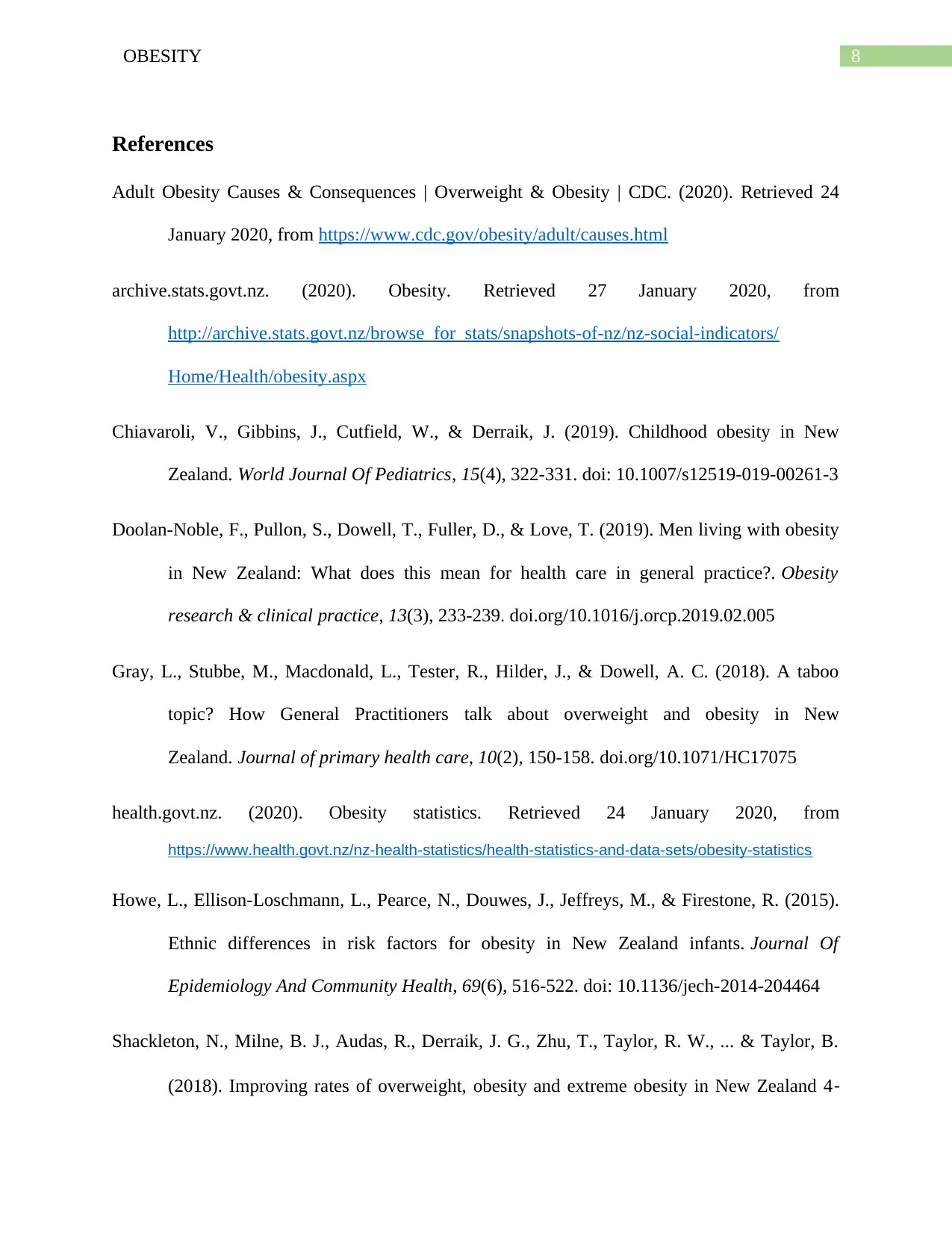
8OBESITY
References
Adult Obesity Causes & Consequences | Overweight & Obesity | CDC. (2020). Retrieved 24
January 2020, from https://www.cdc.gov/obesity/adult/causes.html
archive.stats.govt.nz. (2020). Obesity. Retrieved 27 January 2020, from
http://archive.stats.govt.nz/browse_for_stats/snapshots-of-nz/nz-social-indicators/
Home/Health/obesity.aspx
Chiavaroli, V., Gibbins, J., Cutfield, W., & Derraik, J. (2019). Childhood obesity in New
Zealand. World Journal Of Pediatrics, 15(4), 322-331. doi: 10.1007/s12519-019-00261-3
Doolan-Noble, F., Pullon, S., Dowell, T., Fuller, D., & Love, T. (2019). Men living with obesity
in New Zealand: What does this mean for health care in general practice?. Obesity
research & clinical practice, 13(3), 233-239. doi.org/10.1016/j.orcp.2019.02.005
Gray, L., Stubbe, M., Macdonald, L., Tester, R., Hilder, J., & Dowell, A. C. (2018). A taboo
topic? How General Practitioners talk about overweight and obesity in New
Zealand. Journal of primary health care, 10(2), 150-158. doi.org/10.1071/HC17075
health.govt.nz. (2020). Obesity statistics. Retrieved 24 January 2020, from
https://www.health.govt.nz/nz-health-statistics/health-statistics-and-data-sets/obesity-statistics
Howe, L., Ellison-Loschmann, L., Pearce, N., Douwes, J., Jeffreys, M., & Firestone, R. (2015).
Ethnic differences in risk factors for obesity in New Zealand infants. Journal Of
Epidemiology And Community Health, 69(6), 516-522. doi: 10.1136/jech-2014-204464
Shackleton, N., Milne, B. J., Audas, R., Derraik, J. G., Zhu, T., Taylor, R. W., ... & Taylor, B.
(2018). Improving rates of overweight, obesity and extreme obesity in New Zealand 4‐
References
Adult Obesity Causes & Consequences | Overweight & Obesity | CDC. (2020). Retrieved 24
January 2020, from https://www.cdc.gov/obesity/adult/causes.html
archive.stats.govt.nz. (2020). Obesity. Retrieved 27 January 2020, from
http://archive.stats.govt.nz/browse_for_stats/snapshots-of-nz/nz-social-indicators/
Home/Health/obesity.aspx
Chiavaroli, V., Gibbins, J., Cutfield, W., & Derraik, J. (2019). Childhood obesity in New
Zealand. World Journal Of Pediatrics, 15(4), 322-331. doi: 10.1007/s12519-019-00261-3
Doolan-Noble, F., Pullon, S., Dowell, T., Fuller, D., & Love, T. (2019). Men living with obesity
in New Zealand: What does this mean for health care in general practice?. Obesity
research & clinical practice, 13(3), 233-239. doi.org/10.1016/j.orcp.2019.02.005
Gray, L., Stubbe, M., Macdonald, L., Tester, R., Hilder, J., & Dowell, A. C. (2018). A taboo
topic? How General Practitioners talk about overweight and obesity in New
Zealand. Journal of primary health care, 10(2), 150-158. doi.org/10.1071/HC17075
health.govt.nz. (2020). Obesity statistics. Retrieved 24 January 2020, from
https://www.health.govt.nz/nz-health-statistics/health-statistics-and-data-sets/obesity-statistics
Howe, L., Ellison-Loschmann, L., Pearce, N., Douwes, J., Jeffreys, M., & Firestone, R. (2015).
Ethnic differences in risk factors for obesity in New Zealand infants. Journal Of
Epidemiology And Community Health, 69(6), 516-522. doi: 10.1136/jech-2014-204464
Shackleton, N., Milne, B. J., Audas, R., Derraik, J. G., Zhu, T., Taylor, R. W., ... & Taylor, B.
(2018). Improving rates of overweight, obesity and extreme obesity in New Zealand 4‐
⊘ This is a preview!⊘
Do you want full access?
Subscribe today to unlock all pages.

Trusted by 1+ million students worldwide
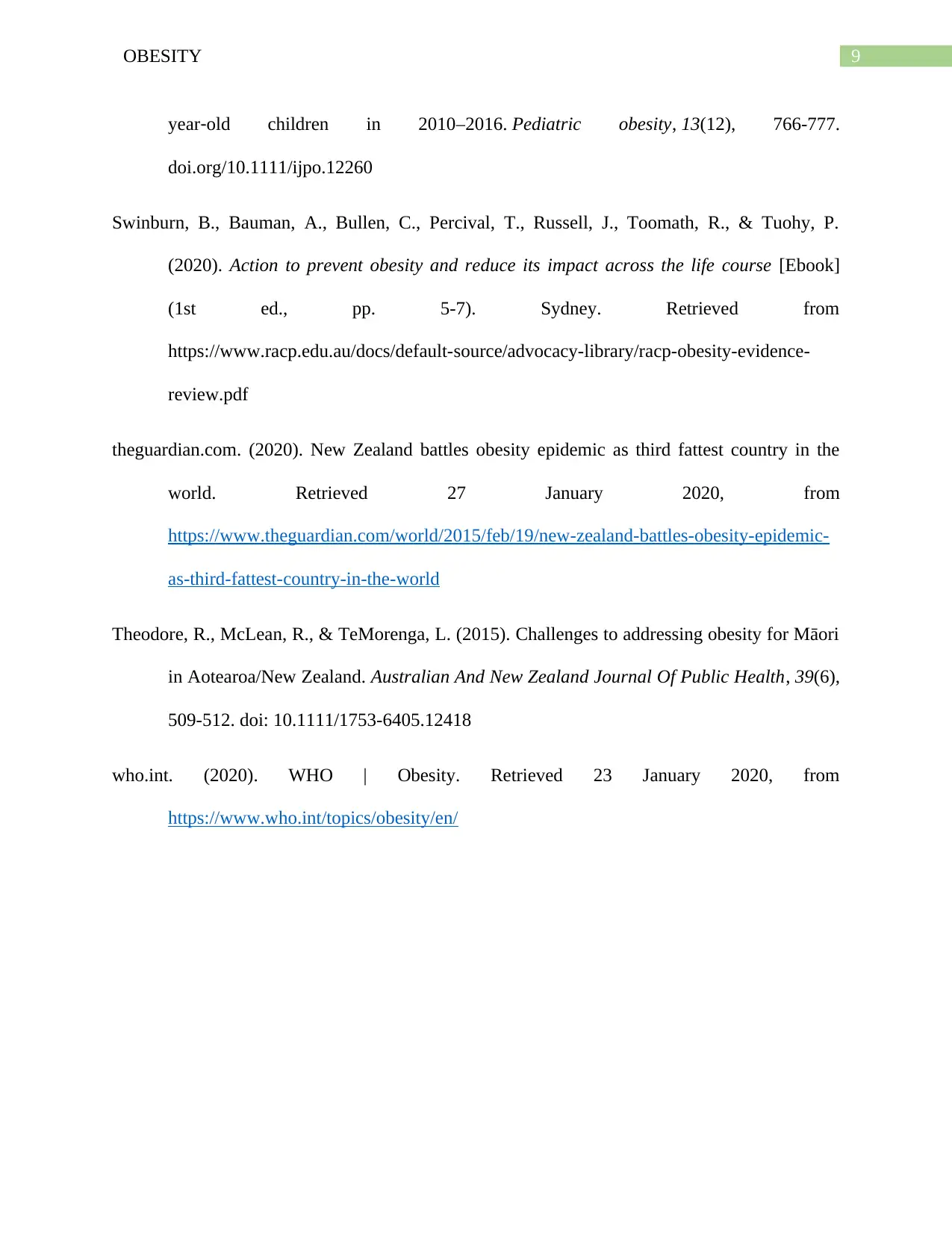
9OBESITY
year‐old children in 2010–2016. Pediatric obesity, 13(12), 766-777.
doi.org/10.1111/ijpo.12260
Swinburn, B., Bauman, A., Bullen, C., Percival, T., Russell, J., Toomath, R., & Tuohy, P.
(2020). Action to prevent obesity and reduce its impact across the life course [Ebook]
(1st ed., pp. 5-7). Sydney. Retrieved from
https://www.racp.edu.au/docs/default-source/advocacy-library/racp-obesity-evidence-
review.pdf
theguardian.com. (2020). New Zealand battles obesity epidemic as third fattest country in the
world. Retrieved 27 January 2020, from
https://www.theguardian.com/world/2015/feb/19/new-zealand-battles-obesity-epidemic-
as-third-fattest-country-in-the-world
Theodore, R., McLean, R., & TeMorenga, L. (2015). Challenges to addressing obesity for Māori
in Aotearoa/New Zealand. Australian And New Zealand Journal Of Public Health, 39(6),
509-512. doi: 10.1111/1753-6405.12418
who.int. (2020). WHO | Obesity. Retrieved 23 January 2020, from
https://www.who.int/topics/obesity/en/
year‐old children in 2010–2016. Pediatric obesity, 13(12), 766-777.
doi.org/10.1111/ijpo.12260
Swinburn, B., Bauman, A., Bullen, C., Percival, T., Russell, J., Toomath, R., & Tuohy, P.
(2020). Action to prevent obesity and reduce its impact across the life course [Ebook]
(1st ed., pp. 5-7). Sydney. Retrieved from
https://www.racp.edu.au/docs/default-source/advocacy-library/racp-obesity-evidence-
review.pdf
theguardian.com. (2020). New Zealand battles obesity epidemic as third fattest country in the
world. Retrieved 27 January 2020, from
https://www.theguardian.com/world/2015/feb/19/new-zealand-battles-obesity-epidemic-
as-third-fattest-country-in-the-world
Theodore, R., McLean, R., & TeMorenga, L. (2015). Challenges to addressing obesity for Māori
in Aotearoa/New Zealand. Australian And New Zealand Journal Of Public Health, 39(6),
509-512. doi: 10.1111/1753-6405.12418
who.int. (2020). WHO | Obesity. Retrieved 23 January 2020, from
https://www.who.int/topics/obesity/en/
1 out of 10
Related Documents
Your All-in-One AI-Powered Toolkit for Academic Success.
+13062052269
info@desklib.com
Available 24*7 on WhatsApp / Email
![[object Object]](/_next/static/media/star-bottom.7253800d.svg)
Unlock your academic potential
Copyright © 2020–2025 A2Z Services. All Rights Reserved. Developed and managed by ZUCOL.





